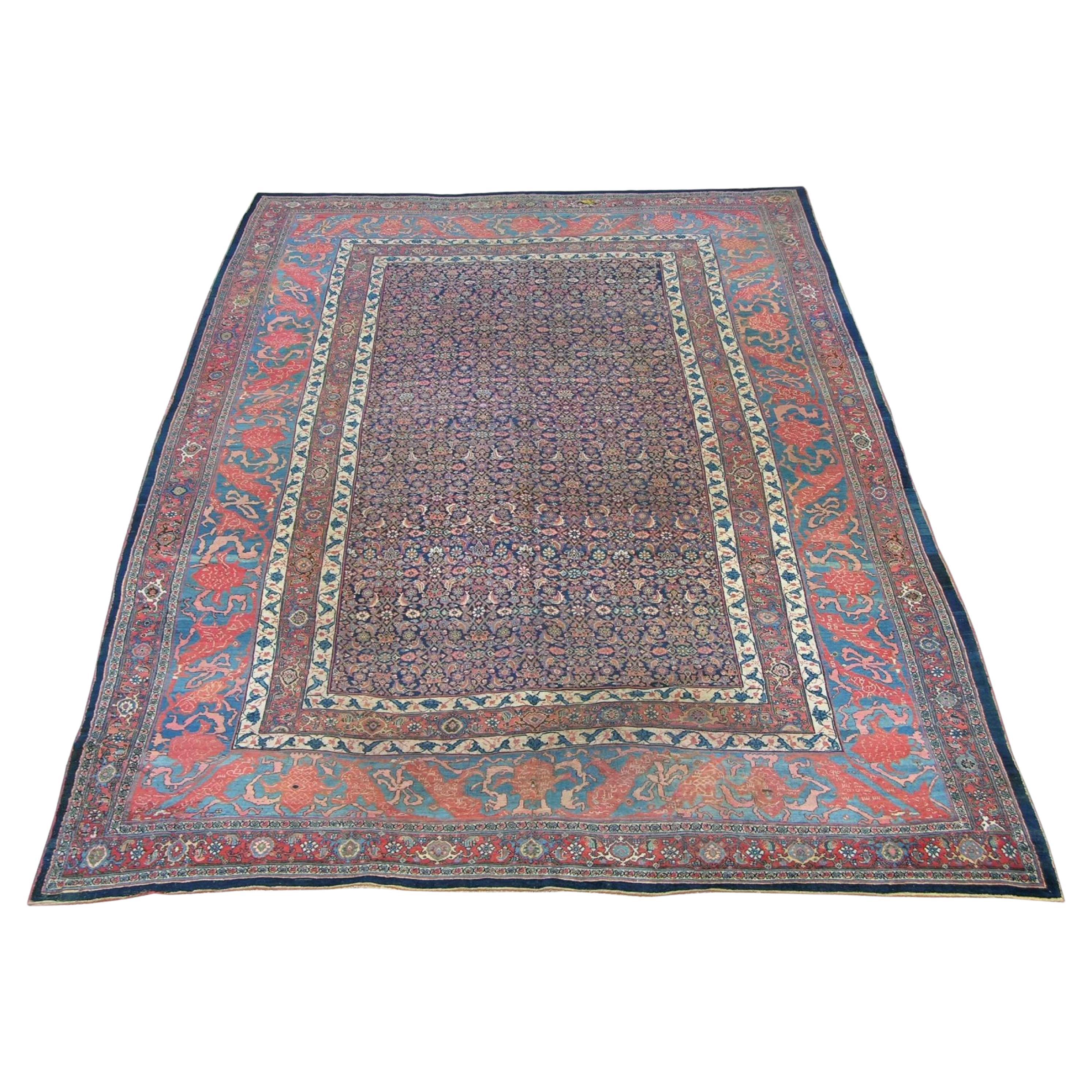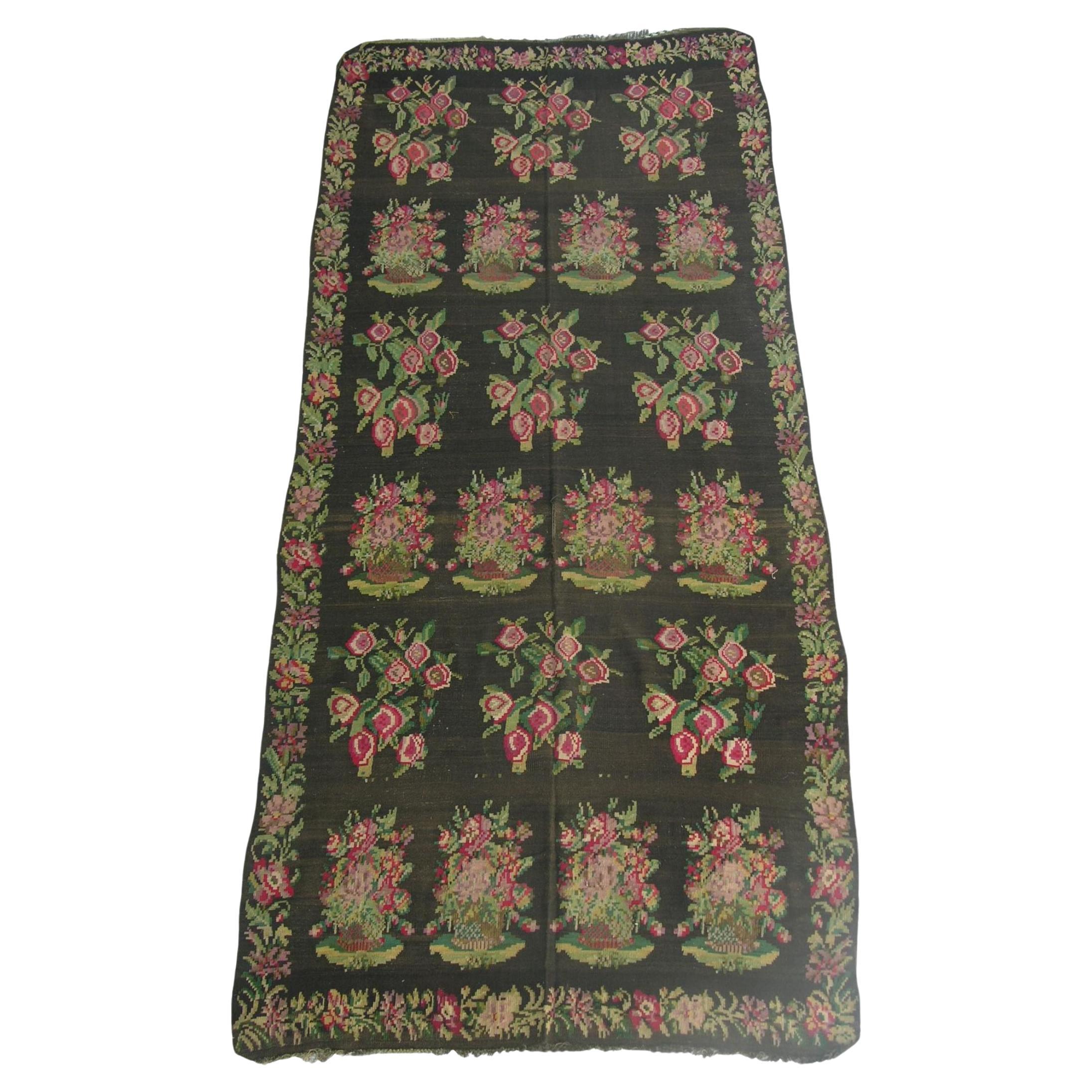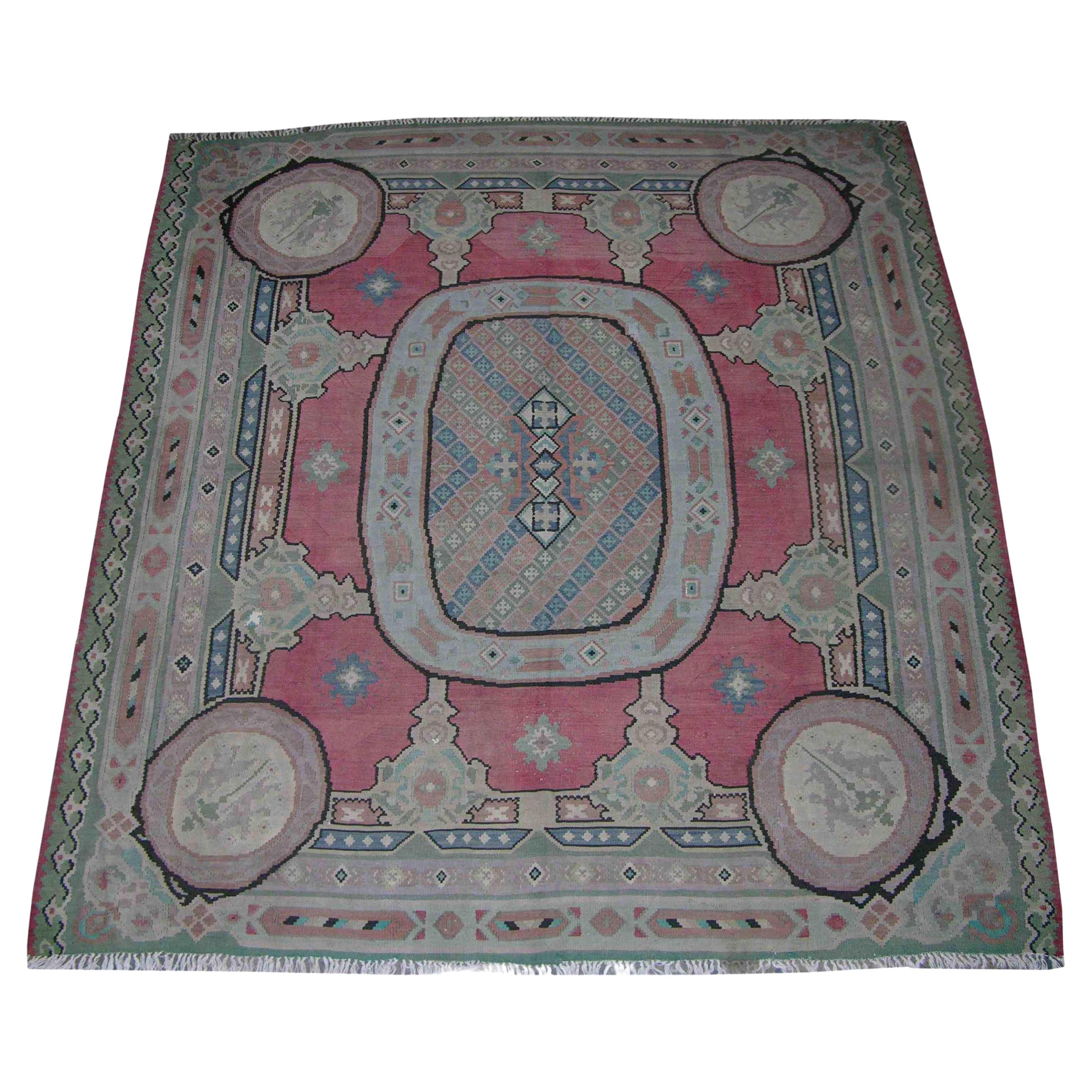Items Similar to Antique Kilim Runner Rug 17'2'' X 6'11''
Want more images or videos?
Request additional images or videos from the seller
1 of 5
Antique Kilim Runner Rug 17'2'' X 6'11''
About the Item
Antique rugs that are called “Kilim rugs”, primarily refer to a type of flat weave rug that was produced without knotted pile. Because these antique rugs are found across the globe, each region has a different pronunciation and spelling of the name Kilim. Homers Iliad and Egyptian tomb paintings, from the same time period, depict weavers producing rugs and carpets of this kind.
Since this is one of the oldest methods of rug production, it is considered to be primitive compared to Oriental hand knotted rugs. Comprised of simple interlocking strands of wool, hair or fiber, Kilims are durable, decorative and used for many purposes. Some of these uses include, clothing, shelter, storage, floor coverings, pillows and barter / trade.
Once overlooked as utilitarian, low status items, antique Kilims are now prized as some of the most powerful and authentic weaving of the Middle East. Kilim rugs (Gilim in Persian) is a Turkish word denoting Caucasus made in simple flat-woven or tapestry technique, in which the pattern is produced entirely by horizontal wefts that cover the vertical warps.
This technique makes it very difficult to produce continuous vertical linear separations of color in the design, so Kilims often have a stepped or crenelated effect. While the weaving quality of kilims can be fine, they tend to rely more on large-scale patterns with striking drawing and effects of color. They may utilize allover designs or grand shield-like medallions.
The most well known Kilims are those of Turkey or Anatolia, which are varied in type and effect, but Caucasian and Persian Jajim and Kilim rugs are also appreciated nowadays for their color and high technical skill. Given their thinner, supple structure, Kilim rugs are usable not only as decorative floor covering, but also as wall hangings and on furniture or bed coverlets as well.
Originating in Anatolia and the Caucasus, flat woven kilims and tribal symbols gradually transitioned to pile rugs as nomadic and semi-nomadic herders ebbed back and forth across the continent. Traditions from turkey and the Levant traveled steadily eastward to the Mougal / Mughal states of Pakistan and India as well as Buddhist regions of Tibet, China and East Turkestan.
Kilim rugs are beautiful Middle Eastern masterpieces that denote pile-less textiles. Because these rugs do not feature that additional backing, they are often much thinner and easier to apply to walls as tapestries or on top of bare-bones flooring and other sections around the room. These rugs follow a specific flat-weaving technique that originated around Turkey, North Africa, Iran and Afghanistan. As these weaving techniques spread around the world, weavers from all over began to develop their own kilim rugs, incorporating their own traditional cultural elements through the use of this style of weaving.
kilims feature muted colors and thin textures to allow the picture itself to stand out as the most noticeable feature on the rug’s surface. Warm colors are often used as the primary hues throughout, though many kilims tend to balance the landscape by also applying cooler tones, which help create points of contrast that entice the viewer’s responsiveness. Classical Turkish motifs are also often used along the rug’s surface, with elements such as perennials, pomegranates and fronds featured heavily in both borders and centers. The flow of movement generally varies from rug to rug, though angular motions are used more often to establish a central degree of grounding. Decorating with kilims can be as simple as setting them alongside other muted elements to create a pleasant transition for the eyes.
Many kilims use sharply contrasting colors to stand out as centerpieces, but the muted tones are otherwise best applied as an accenting force, especially if there are brighter and more noticeable furnishings present in the room. Set kilims alongside furnishings or underneath functional pieces of furniture, such as tables and chairs, to allow the room’s dynamic to flow more elegantly, especially if there are neutral tones and lighter colors that can match the kilim’s degree of visibility.
- Dimensions:Width: 83 in (210.82 cm)Length: 206 in (523.24 cm)
- Style:Other (In the Style Of)
- Materials and Techniques:
- Place of Origin:
- Period:1900-1909
- Date of Manufacture:1900
- Condition:good condition one of a kind.
- Seller Location:Los Angeles, US
- Reference Number:
About the Seller
5.0
Gold Seller
These expertly vetted sellers are highly rated and consistently exceed customer expectations.
Established in 1920
1stDibs seller since 2023
26 sales on 1stDibs
Typical response time: <1 hour
- ShippingRetrieving quote...Ships From: Los Angeles, US
- Return PolicyA return for this item may be initiated within 3 days of delivery.
More From This SellerView All
- Antique Kilim Geometric Runner Rug 13'1'' X 5'11''Located in Los Angeles, USAntique rugs that are called “Kilim rugs”, primarily refer to a type of flat weave rug that was produced without knotted pile. Because these antique rugs are found across the globe, ...Category
Antique Early 1900s Asian Other Russian and Scandinavian Rugs
MaterialsWool, Cotton
- Antique Kilim Runner Rug 14'4'' X 4'10''Located in Los Angeles, USAntique Kilim Runner Rug 14'4'' X 4'10''Category
Antique Early 1900s Asian Other Russian and Scandinavian Rugs
MaterialsWool, Cotton
- Antique Bidjar Rug with Floral Design 17'8''x11'7''Located in Los Angeles, USAntique Bidjar Rugs Bidjar is a town in Persian Kurdistan located in north-west Persia. The Bidjar name is also used to describe the antique rugs that were produced in the many villa...Category
Antique Early 1900s Asian Other Russian and Scandinavian Rugs
MaterialsWool, Cotton
- Early 20th Century Antique Kilim RunnerLocated in Los Angeles, USAntique rugs that are called “Kilim rugs”, primarily refer to a type of flat weave rug that was produced without knotted pile. Because these antique rugs are found across the globe, ...Category
Antique Early 1900s Asian Other Russian and Scandinavian Rugs
MaterialsWool, Cotton
- 1910s Antique Kilim RugLocated in Los Angeles, USAntique rugs that are called “Kilim rugs”, primarily refer to a type of flat weave rug that was produced without knotted pile. Because these antique rugs are found across the globe, ...Category
Antique Early 1900s Asian Other Russian and Scandinavian Rugs
MaterialsWool, Cotton
- Antique Oushak Rug 11.2x9.2Located in Los Angeles, USAntique Turkish Oushak rugs have been woven in Western Turkey since the beginning of the Ottoman period. Historians attributed to them many of the great masterpieces of early Turkish...Category
Antique Early 1900s Other Russian and Scandinavian Rugs
MaterialsWool, Cotton
You May Also Like
- Russian Antique Karabagh Runner Rug by Rug & KilimLocated in Long Island City, NYOriginating from Russia in 1890, this antique Karabagh runner hosts an interesting, uncommon play on the Classic Boteh (paisley) pattern; an eastern symbol of flame and the universe....Category
Antique 1890s Russian Russian and Scandinavian Rugs
MaterialsWool
- Antique Russian Runner Rug Karebagh DesignLocated in Dallas, TXAntique Russian runner rug handwoven from the finest sheep’s wool. It’s colored with all-natural vegetable dyes that are safe for humans and pets. ...Category
20th Century Russian Other Russian and Scandinavian Rugs
MaterialsWool
- Antique Russian Runner Rug Karebagh DesignLocated in Dallas, TXAntique Russian runner rug handwoven from the finest sheep’s wool. It’s colored with all-natural vegetable dyes that are safe for humans and pets. ...Category
20th Century Russian Other Russian and Scandinavian Rugs
MaterialsWool
- Antique Russian Runner Rug Karebagh DesignLocated in Dallas, TXAntique Russian runner rug handwoven from the finest sheep’s wool. It’s colored with all-natural vegetable dyes that are safe for humans and pets. ...Category
20th Century Russian Other Russian and Scandinavian Rugs
MaterialsWool
- Antique Karabagh Runner Beige Brown Classic Rug & Boteh Pattern by Rug & KilimLocated in Long Island City, NYHand knotted in wool originating from Russia circa 1890-1900, this antique runner connotes a 19th century Karabagh rug design, employing an atypical play of Classic beige-brown and b...Category
Antique 1890s Russian Tribal Russian and Scandinavian Rugs
MaterialsWool
- Antique Kazak Runner Rug with Red & Blue Geometric Patterns, from Rug & KilimLocated in Long Island City, NYHand-knotted in wool and hailing from Russia circa 1910-1920, this 3x6 antique Kazak runner rug is a rare Caucasian tribal curation from the collection by Rug & Kilim. On the Desi...Category
Vintage 1910s Russian Tribal Russian and Scandinavian Rugs
MaterialsWool




